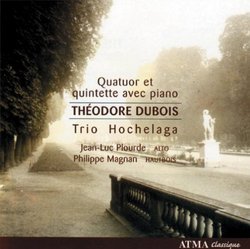| All Artists: Theodore Dubois, Trio Hochelaga, Stephane Lemelin Title: Théodore Dubois: Quatuor et quintette avec piano Members Wishing: 0 Total Copies: 0 Label: Atma Classique Original Release Date: 1/1/2007 Re-Release Date: 6/5/2007 Genre: Classical Styles: Chamber Music, Historical Periods, Classical (c.1770-1830) Number of Discs: 1 SwapaCD Credits: 1 UPC: 722056238526 |
Search - Theodore Dubois, Trio Hochelaga, Stephane Lemelin :: Théodore Dubois: Quatuor et quintette avec piano
 | Theodore Dubois, Trio Hochelaga, Stephane Lemelin Théodore Dubois: Quatuor et quintette avec piano Genre: Classical |
Larger Image |
CD Details |
CD ReviewsFranckian Chamber Music by a Neglected Composer J Scott Morrison | Middlebury VT, USA | 01/14/2008 (4 out of 5 stars) "'I don't think that people have always been fair and equitable towards me ... I am not vain, but I still think some of my works deserve better than the cold disdain that has greeted them.' -- Théodore Dubois, in his diary not long before he died.
All but unknown now, except for a sacred oratorio -- Les sept paroles du Christ (The Seven Last Words of Christ) -- that is occasionally performed, French composer Théodore Dubois (1837-1924) wrote extensively in all genres and also, in his role as professor, wrote several musical treatises, among them a profound work on the music of Gounod, that are still consulted. He was director of the Paris Conservatoire from 1896 to 1905. It was in the latter year that he wrote the most unusual work on this disc, the Quintet for Piano, Violin, Oboe, Viola and Cello. Two years later he wrote the disc's other work, the Piano Quartet. In his early years he was choir director and assistant organist at Ste. Clotilde under César Franck whose music his at least superficially resembles. The Piano Quartet is a solidly constructed, unfailingly melodious work in the usual four movements. Harmonically it reminds one of Franck in some of his less adventuresome works. Certainly, for its time (1907) it is quite conservative. After a first movement with sweeping melodies and some harmonic turbulence, the second movement -- Andante molto -- provides a serene respite. The Scherzo is light-hearted, even elfin, and sounds almost like similar music by Saint-Saëns or even Mendelssohn. The finale incorporates themes from the previous three movements, reminiscent of Franck's familiar cyclic form. This movement feels like a 'big statement' summarizing all that has gone before. The movement's coda brings the Quartet to a brilliant finish. The Quintet is unusual for incorporating an oboe along with the usual piano quartet instrumentation. It was written for several of Dubois's colleagues at the Conservatoire, including pianist Louis Diémer, Cortot's teacher. The score notes that the oboe can be replaced by a clarinet. In this performance the fine Québecois oboist, Philippe Magnan, joins the Trio Hochelaga (Anne Robert, violin; Paul Marleyn, cello; Stéphane Lemelin, piano) and violist Jean-Luc Plourde. (The Trio's name comes from the Iroquois name for Montréal.) The oboe plays much of the time in its lower register almost as if it were the second violinist in a standard piano quintet. This lends a piquant timbre that somehow gives the work a more 'modern' sound -- and certainly a more French sound -- than would be the case with either a second violin or even a clarinet. The Allegro is a breezily optimistic essay that is followed by a subdued Canzonetta that tiptoes to a cautious outpouring of songful melancholy. This is followed by sentimental Adagio non troppo that features interplay of the oboe and viola. The finale, Allegro con fuoco, cyclical in its use of previous motifs, blazes to a breathless finish. I had never heard either of these works before and am very happy to make their acquaintance. The quintet in particular is a real find. Both the playing by these fine young musicians and the recorded sound they are given are all one could ask for. Scott Morrison" |
